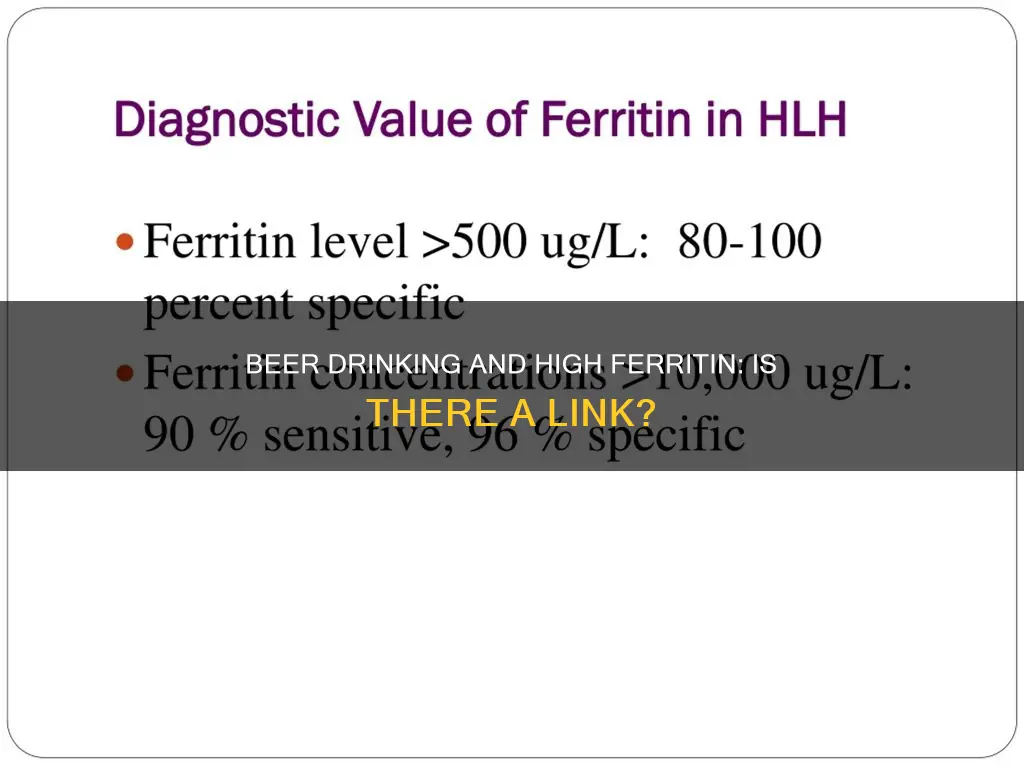
Alcohol consumption has been linked to an increased risk of iron overload in the body, which can lead to serious health issues such as alcoholic liver disease. Research shows that even mild to moderate alcohol consumption can increase iron stores in the body, with serum iron and ferritin levels increasing progressively across all alcohol intake classes.
Beer, in particular, has been found to have a greater effect on iron levels than wine or spirits. Individuals with a history of alcohol dependency are more likely to have higher ferritin levels.
While moderate alcohol consumption may reduce the risk of iron deficiency and iron deficiency anemia, consuming more than two alcoholic drinks per day is associated with a significantly elevated risk of iron overload. Therefore, it is important to monitor alcohol intake to maintain healthy iron levels and reduce the risk of associated health complications.
| Characteristics | Values |
|---|---|
| Alcohol intake | Low levels of alcohol intake increase ferritin levels. |
| Alcohol dependency | There were significantly higher ferritin levels in subjects with an alcohol dependency history. |
| Alcohol consumption | The risk of iron overload is elevated by consumption of more than 2 alcoholic drinks per day. |
| Alcohol and iron overload | Alcohol increases the body's iron stores. |
| Alcohol and iron overload | Alcohol abuse can lead to iron overload, which can cause alcoholic liver disease. |
| Alcohol and iron deficiency | Consumption of up to 2 alcoholic drinks a day is associated with a reduced risk of iron deficiency. |
| Alcohol and anaemia | Consumption of up to 2 alcoholic drinks a day is associated with a reduced risk of anaemia. |
| Alcohol and ferritin levels | With alcohol abstinence, ferritin levels drop rapidly in people who abuse alcohol. |
| Alcohol and iron levels | Alcohol consumption is associated with increased iron levels. |
What You'll Learn

Alcohol intake and ferritin levels
Alcohol intake has been found to increase ferritin and body iron stores. This increase is progressive across classes of alcohol intake, with beer consumption having a greater effect than wine or spirits. Ferritin concentration is significantly higher in subjects who have ever been alcohol dependent.
Alcohol intake at a low level can increase ferritin and, by inference, body iron stores. This may be either beneficial or harmful, depending on circumstances. The response of biological markers of alcohol intake can be affected by body iron stores, which has implications for test sensitivity and specificity and for variation in biological responses to alcohol use.
Chronic, excessive alcohol consumption can cause secondary iron overload, which can lead to serious health problems like alcoholic liver disease. Alcohol intake makes your body increase its level of iron storage. Adults who drink moderate amounts of alcohol have reduced risks of developing an iron deficiency. This level of alcohol intake is typically too low to trigger the onset of iron overload. If you consume more than one or two drinks daily, you elevate your risk for iron overload. But elevated risks occur in people who abuse alcohol and who habitually drink to considerable excess.
Excessive alcohol consumption frequently leads to an abnormal build-up of iron in the liver, which can contribute to the onset of alcoholic liver disease (ALD). Iron overload can also be caused by other factors, such as blood disorders, hepatitis C, multiple blood transfusions, and excessive consumption of iron supplements.
If you’re abusing alcohol and are worried about iron overload, quitting alcohol is ideal. By abstaining completely, you can significantly reduce the risk of iron overload and hemochromatosis. When you stop drinking for an extended period, your iron levels may return to normal.
There is currently no cure for hemochromatosis, but quitting or minimising alcohol consumption can help. By limiting your alcohol intake, you can relieve yourself of hemochromatosis symptoms and reduce the risk of damage to your heart, liver, and pancreas.
Skunked Beer: Is It Safe to Drink?
You may want to see also

Iron overload and ferritin levels
Iron overload, or hemochromatosis, is a medical condition that occurs when excessive iron builds up in the body, leading to toxic reactions. While iron is essential for various metabolic processes, an overload can have detrimental effects on organs such as the liver, heart, and endocrine glands. This condition can be primary or secondary in nature.
Primary iron overload, often inherited, is caused by genetic mutations, with the most common being a mutation in the HFE gene, known as hereditary hemochromatosis. This mutation results in increased intestinal absorption of iron, leading to excessive deposits in organs. Other less common genetic mutations include those in the HAMP, HJV, TFR2, and SLC40A1 genes.
Secondary iron overload arises from factors such as blood transfusions, hemolysis, or excessive parenteral or dietary iron intake. Alcohol consumption is a significant contributor to secondary iron overload. Excessive and long-term alcohol intake increases the risk of iron overload and can lead to alcoholic liver disease. Alcohol disrupts iron metabolism, releasing large amounts of iron into the circulation, resulting in elevated ferritin levels.
Ferritin is an acute-phase reactant protein that reflects iron stores in the body. High ferritin levels can be caused by various factors, including inflammation, infection, liver disease, renal disease, alcohol excess, metabolic syndrome, or malignancy. However, a high ferritin level does not always indicate iron overload. Iron overload is typically indicated by a transferrin saturation (TSAT) of more than 45%.
The treatment for iron overload aims to reduce iron levels and can be achieved through therapeutic phlebotomy or iron chelation therapy. Early detection and treatment of iron overload are crucial to prevent serious organ damage and premature death.
In summary, iron overload, or hemochromatosis, is a condition caused by excessive iron buildup, which can be primary (genetic) or secondary (lifestyle and medical factors). Alcohol consumption is a significant contributor to secondary iron overload and can lead to severe health complications. Ferritin levels are used as an indicator of iron stores in the body, but a high ferritin level alone does not always indicate iron overload. Treatment for iron overload focuses on reducing iron levels through therapeutic phlebotomy or chelation therapy.
Celiac-Friendly Modelo Beer: Is It Safe to Drink?
You may want to see also

Alcohol abuse and ferritin levels
Alcohol abuse can lead to a dangerous condition known as hemochromatosis, or iron overload. This condition occurs when the body absorbs too much iron, resulting in a toxic reaction. While the digestive system typically absorbs the necessary amount of iron from food, excessive alcohol consumption can cause the intestines to absorb too much. This leads to an increased risk of developing hemochromatosis, which can have serious health consequences.
The link between alcohol abuse and hemochromatosis is well-established. Alcohol intake increases the body's iron storage, and those who drink excessive amounts of alcohol are at a higher risk of developing iron overload. Specifically, consuming more than one or two drinks per day elevates this risk. The excessive alcohol consumption leads to an abnormal build-up of iron in the liver, which can contribute to alcoholic liver disease (ALD). ALD is a potentially fatal disorder and is the primary result of alcohol-related iron overload.
The effects of alcohol consumption on iron stores were studied on 3375 adult twin subjects in Australia. The results showed that serum iron and ferritin levels increased with higher alcohol intake. Additionally, the effects of beer consumption were found to be greater than those of wine or spirits. This study provides further evidence of the link between alcohol abuse and increased ferritin levels, which can lead to hemochromatosis.
The consequences of hemochromatosis can be severe and include unusual fatigue or weakness, unexplained weight loss, darkening of the skin, joint and abdomen pain, liver cirrhosis, and increased susceptibility to certain bacterial infections. Therefore, it is crucial to address alcohol abuse to reduce the risk of developing hemochromatosis and its associated complications.
If an individual is concerned about iron overload due to alcohol abuse, quitting alcohol is the ideal solution. Abstaining from alcohol can significantly reduce the risk of hemochromatosis, and prolonged abstinence can help iron levels return to normal. Additionally, maintaining moderate alcohol consumption can minimize the risk of developing or worsening the condition.
Nutrisystem and Beer: What You Need to Know
You may want to see also

Alcoholic liver disease and ferritin levels
Alcoholic liver disease is a progressive inflammatory liver injury associated with long-term heavy alcohol consumption. Alcohol abuse can disrupt iron metabolism, releasing large amounts of iron into the circulation and causing abnormally high ferritin levels. Ferritin is an essential protein that stores and releases iron, regulating its levels in the body.
The relationship between alcohol consumption and ferritin levels has been observed in several studies. One study found that serum iron and ferritin levels increased with higher alcohol intake, with beer consumption having a more significant impact than wine or spirits. This correlation was also evident in individuals with a history of alcohol dependence, who exhibited significantly higher ferritin concentrations.
Alcoholic liver disease can manifest in several ways, including alcoholic fatty liver disease, alcoholic hepatitis, and cirrhosis. Alcoholic hepatitis, in particular, is characterised by inflammation of the liver and elevated transaminase levels. The condition can lead to severe complications, including jaundice, malaise, tender hepatomegaly, and even liver cirrhosis.
The excessive release of ferritin in alcoholic liver disease can be attributed to the damage caused to hepatocytes, which are the primary cells of the liver. This release of ferritin can mimic iron overload disorders such as hereditary hemochromatosis (HH), especially in patients with high transferrin saturation and underlying liver cirrhosis. Therefore, early recognition of these features is crucial to prevent unnecessary phlebotomy and initiate appropriate treatment.
Elevated ferritin levels are a non-specific finding often associated with acute or chronic inflammation, alcoholic liver disease, or iron overload disorders. However, it is important to note that ferritin levels can also be influenced by other factors, such as infection.
Beer Batters: How Do They Work?
You may want to see also

Alcohol and iron overload
Alcohol intake increases the body's level of iron storage. Adults who drink moderate amounts of alcohol have a reduced risk of developing iron deficiency. This level of alcohol intake is typically too low to trigger the onset of iron overload. However, consuming more than one or two drinks daily increases the risk of iron overload. This risk is elevated in people who abuse alcohol and drink to excess.
Chronic, excessive alcohol consumption frequently leads to an abnormal build-up of iron in the liver, which can contribute to alcoholic liver disease (ALD). ALD is a potentially fatal disorder characterised by hepatitis, cirrhosis, and liver tissue destruction. Other problems associated with ALD include an abnormal accumulation of fat in the liver, portal hypertension, and hepatic encephalopathy.
Iron overload can lead to serious health problems, including unusual fatigue or weakness, unexplained weight loss, darkening of the skin, a significant drop in libido, joint and abdomen pain, cirrhosis, and increased susceptibility to certain types of bacteria.
Quitting alcohol is the ideal way to reduce the risk of hemochromatosis. Abstaining from alcohol can normalise iron levels. Other treatments for hemochromatosis include phlebotomy, chelation therapy, and dietary changes, such as limiting alcohol intake and avoiding iron-fortified foods and supplements.
A Beer Lover's Guide to Mohegan Sun Fest
You may want to see also
Frequently asked questions
Yes, alcohol consumption increases ferritin levels and, therefore, iron stores in the body.
Yes, ferritin levels drop rapidly in people who abuse alcohol if they stop drinking.
Yes, consuming alcohol in excess over time can lead to iron overload, which can cause alcoholic liver disease, a potentially fatal disorder.
Yes, ferritin levels can return to normal.







